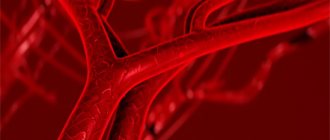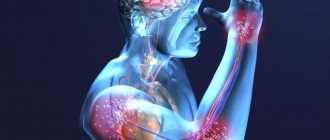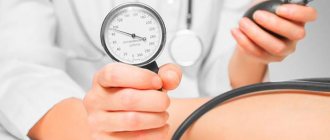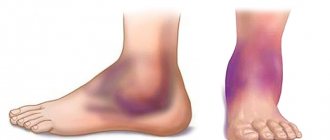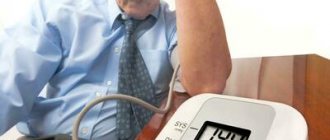Efficiency. Professionalism. Mercy
Heart pain due to angina pectoris
Coronary heart disease is a chronic disease that manifests itself as periodic attacks of pain in the heart or behind the sternum.
Attacks of angina pectoris occur during physical exertion, emotional experiences, as well as with increased blood pressure, diabetes mellitus and other situations.
Signs of angina: paroxysmal, squeezing or pressing pain behind the sternum, lasting up to 20 minutes. The pain radiates to the left shoulder, forearm, hand, and shoulder blade. There may be hard-to-explain sensations in the chest, a feeling of lack of air, and causeless weakness. Possible increased frequency of attacks and increased pain.
Help with pain syndrome:
- If pain occurs during exercise, you must immediately stop working and, if possible, sit comfortably, without tension, with your legs down.
- Provide access to fresh air (open a window, unbutton clothing that makes breathing difficult).
- Take Nitromint aerosol one dose (0.4 mg) or Nitroglycerin 1 tablet (0.0005 g) under the tongue, if necessary, can be repeated after 3-5 minutes, up to 3 doses in total.
- Take Acetylsalicylic acid (aspirin) – chew 1 tablet (0.5 g) or 4 tablets of Clopidogrel (300 mg).
- If the pain does not go away after taking these medications, call an ambulance.
Remember! Nitroglycerin lowers blood pressure, as indicated by the appearance of severe weakness, sweating, nausea, pale skin, and headache. Therefore, “to be safe,” you cannot take 2-3 tablets at the same time.
Heart pain during acute myocardial infarction
If the symptoms (complaints) described above last for more than 20 minutes, cold, sticky sweat appears, a feeling of fear, pallor, fingertips and lips turn blue, and possible single vomiting occurs, then you can think about myocardial infarction.
Only a medical specialist can recognize an acute heart attack at an early stage.
Help with pain syndrome:
- Call an ambulance.
- Go to bed.
- Take Nitromint aerosol one dose (0.4 mg) or Nitroglycerin 1 tablet (0.0005 g) under the tongue, if necessary, can be repeated after 3-5 minutes, up to 3 doses in total.
- Take Acetylsalicylic acid (aspirin) – chew 1 tablet (0.5 g) or 4 tablets of Clopidogrel (300 mg)
If the heart attack passed quickly and you did not call an ambulance, then you need to contact your local physician on the same day (call to your home).
Follow these tips and they will help you avoid complications and save your life.
Ways to Prevent a Heart Attack
If a patient is diagnosed with coronary heart disease (CHD) or experiences a sharp increase in blood pressure, it is recommended to always have nitroglycerin and aspirin with you. The risk of developing a heart attack is much higher:
- in the presence of great physical and psychological stress;
- with excessive cholesterol levels in the blood;
- alcohol abuse;
- smoking;
- the presence of a genetic predisposition.
It is important that relatives or others have basic CPR (cardiopulmonary resuscitation) skills, measuring blood pressure, pulse, and heart rate.
If you are predisposed to a heart attack, it is recommended to regularly visit a cardiologist and keep a “Diary” in which you note your pulse and blood pressure daily. The “Blood Pressure Control Diary” should be shown to the doctor in order to select effective drug therapy.
Best materials of the month
- Coronaviruses: SARS-CoV-2 (COVID-19)
- Antibiotics for the prevention and treatment of COVID-19: how effective are they?
- The most common "office" diseases
- Does vodka kill coronavirus?
- How to stay alive on our roads?
Main clinical signs of heart disease
To be able to see a doctor as early as possible, it is necessary to study the main symptoms of cardiac diseases. Depending on the characteristics of the disease, they can differ significantly, but in most situations the following signs are diagnosed: • discomfort in the chest area. This is the most common symptom. It may manifest itself as a feeling of squeezing, burning or tingling, but in any case requires attention; • nausea, heartburn and indigestion. These are indirect signs, and they indicate cardiac problems only in combination with other, more obvious symptoms; • pain that radiates to the arm. This is one of the signs that requires special attention. Often, pain is localized in the chest area, after which it spreads along the left side of the body; • dizziness and a feeling of lightness in the head. When combined with other clinical signs, these symptoms may indicate cardiac problems; • increased fatigue, which occurs after minor physical exertion and is accompanied by shortness of breath. This symptom should be a reason to consult a doctor; • cold sweat. It also becomes one of the main signs of heart or vascular disease; • cough not associated with a cold. It may indicate that not enough blood is reaching the lungs. Here you need to consult a therapist; • swelling in the legs. May indicate heart failure or other cardiac problems; • arrhythmia. If you feel that your heart rhythm is changing and this condition lasts more than a few seconds or occurs quite often, you should contact a cardiologist; • blood pressure disorders. It often accompanies cardiac problems, and therefore requires attention; • sleep disturbance is an indirect sign that often occurs in combination with the symptoms listed above. If the above conditions are observed systematically, this is a reason to visit a therapist and cardiologist. If indicated, you may need to consult a neurologist. At the same time, it is imperative to undergo a full-scale diagnosis so that the doctor can identify the problem and draw up an effective plan to eliminate it.
Basic therapy methods
Treatment of heart disease can consist of completely different programs, and will depend on the characteristics of the disease and the degree of complexity of the patient’s condition. First of all, at the initial stage, doctors recommend adhering to the following rules: • alternating moderate physical activity and proper rest; • rejection of bad habits; • minimizing stressful situations; • a complete balanced diet, possibly fractional meals; • perform physical therapy; • visiting health resorts of the relevant profile. When the listed measures are few, in simple situations they may recommend general tonics in the form of tinctures: • eleutherococcus; • hawthorn; • valerian and other medicinal herbs. If we talk about larger-scale drug treatment of heart disease, a wide range of drugs can be used here. Everything will depend on the characteristics of the person’s condition. Most often, doctors recommend: • anti-inflammatory drugs; • antiarrhythmic drugs; • cardiological vitamin complexes; • drugs to restore blood composition and normalize blood circulation; • cardiac glycosides; • cardiotonic drugs (cardioprotectors); • calcium antagonists; • alpha-blockers and adrenergic stimulants; • antiplatelet agents; • anticoagulants; • beta-blockers; • vasodilators; • diuretics, including potassium-sparing ones; • inhibitors; • thrombolytics; • nitrates; • potassium and magnesium preparations. In difficult situations, heart disease is treated surgically. Depending on the indications, the following is performed here: • installation of a pacemaker; • shunting; • stenting; • radiofrequency ablation; • valve replacement, etc. The good news is that the possibilities of modern medicine are quite wide, so the treatment of heart diseases is often successful. The main guarantee of positive prognosis is early diagnosis. People who have had cardiac problems and have undergone appropriate treatment should subsequently regularly visit a cardiologist and undergo follow-up diagnostics.
Heart attack in a woman: features of assistance
Before menopause, women are practically not susceptible to cardiovascular disasters (the hormonal background with the predominance of estrogen protects blood vessels from the formation of atherosclerotic plaques). After 50 years, a sharp decrease in the concentration of steroid hormones increases the risk of developing myocardial infarction.
This category of patients is characterized by precursors of the development of a heart attack, which may bother you for 1-2 months:
- sleep disorders, snoring, sleep apnea;
- causeless fatigue, sudden loss of strength, headaches, anxiety;
- progression of periodontal disease;
- shortness of breath, annoying dry cough, swelling of the lower extremities;
- frequent urge to urinate at night;
- manifestation of various paroxysmal heart rhythm disturbances.
Instead of the traditional clinical picture, women often develop atypical variants of a heart attack. Symptoms can simulate an exacerbation of gastrointestinal pathology (gastritis, ulcers, pancreatitis, cholecystitis), obstructive pulmonary diseases (bronchial asthma), and cerebrovascular accidents. A high pain threshold and atypical onset make timely diagnosis and treatment difficult.
The difference between a heart attack is the lack of correlation between the extent of myocardial ischemia and the severity of pain, the addition of various arrhythmias, and the gradual progression of the condition.
The care algorithm is identical to that for men, but the doctor should take into account the greater risk of sudden death and fatal complications in the acute period.
Basic preventive measures
It is better to do everything possible to prevent heart and vascular diseases than to treat them. Therefore, special attention should be paid to preventive measures. They consist of the following points: • maintaining a healthy, active lifestyle; • rejection of bad habits; • balanced nutrition and enrichment of the diet with healthy foods; • exclusion from the diet of too fatty foods, fried foods, spicy and salty foods; • proper rest; • minimizing stressful situations. These are the main preventive measures that are used to prevent cardiac problems. By following these simple tips, you will be able to minimize the risk of heart and vascular diseases. In this case, you will feel much better. It also wouldn’t hurt to familiarize yourself with the rules for providing first aid in the event of an attack, such as a heart attack. In this case, a quick response will help reduce the danger of the situation to human health and life. Therefore, if among your loved ones there are people with cardiac problems, in particular coronary disease, you should study the principles of helping them.
Methods for diagnosing heart disease
First of all, you need to see a doctor for an initial consultation. During this procedure, the doctor examines the patient’s anamnesis and medical history, and also inquires about his heredity. Additionally, blood pressure will be measured and electrocardiography will be performed. The latter is becoming the main method for diagnosing cardiac problems and is considered the most informative procedure. Initially, electrocardiography is performed once, but if indicated, daily monitoring may be recommended. In this case, the cardiogram is recorded for 24 hours. A compact device is connected to a person, which in no way prevents him from leading his usual lifestyle. Based on the results of the study, the doctor will be able to establish a preliminary diagnosis. In some situations, cardiography is carried out under physical exertion on special simulators and at rest in order to understand how the body reacts to increased human activity. Additionally, the following studies will be recommended: • laboratory tests of blood and urine; • Ultrasound of the heart and other organs as indicated; • study of cerebral vessels; • CT or MRI. Based on the diagnosis, the doctor will be able to establish an accurate diagnosis and prescribe effective treatment.
